Fermentation and pickling are fundamentally different preservation methods: fermentation uses live bacteria to transform food over time, while pickling immerses food in vinegar for immediate preservation. The key difference lies in their biochemical processes—fermentation creates living ecosystems that evolve flavors, while pickling locks in flavors through acid saturation. This distinction affects spice behavior, shelf life, and ideal applications.
Whether you're a home preserver or culinary professional, understanding these differences prevents common mistakes and ensures perfect results. We'll break down exactly when to use each method, how spices behave differently in each process, and provide actionable techniques you can implement immediately.
Table of Contents
- What is Fermentation? How It Actually Works
- What is Pickling? The Science Simplified
- Fermentation vs Pickling: Key Differences You Need to Know
- How Spices Behave Differently: Practical Implications
- When to Choose Fermentation vs Pickling
- Proven Techniques for Perfect Results
- Top 5 Mistakes That Ruin Preserved Foods
- Frequently Asked Questions Answered
- Conclusion: Matching Method to Your Goals
What is Fermentation? How It Actually Works
Fermentation preserves food through natural bacteria (mainly lactic acid bacteria) that convert sugars into acids. This living process happens without oxygen and takes days to weeks to complete. During fermentation, beneficial bacteria actively break down ingredients, creating complex flavors that evolve over time.
When preserving vegetables like cabbage or cucumbers, you submerge them in saltwater brine. The salt creates an environment where good bacteria thrive while preventing harmful ones. As fermentation progresses, the pH gradually drops to 3.5-4.2, preserving the food while developing rich, umami flavors.
Spices added during fermentation undergo transformation—their compounds interact with living bacteria, mellowing harsh elements while developing deeper complexity. This is why fermented foods like kimchi or sauerkraut have layered flavors that improve with age.
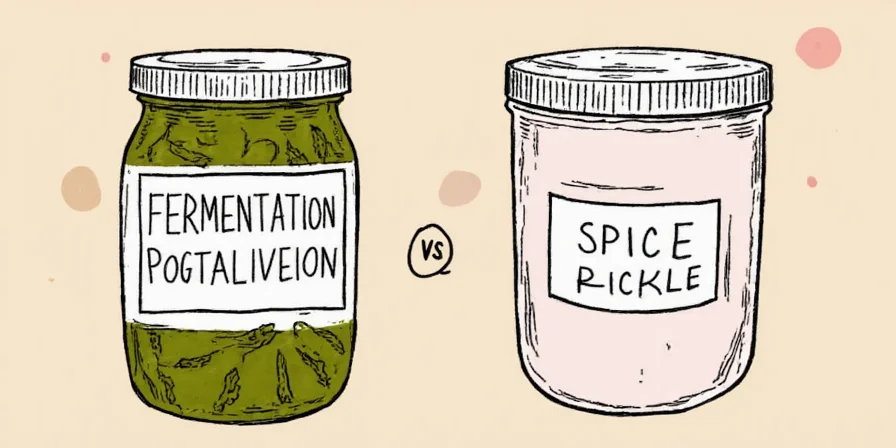
What is Pickling? The Science Simplified
Pickling preserves food through immediate acid exposure, typically using vinegar (5% acetic acid). Unlike fermentation's biological process, pickling works chemically—the acid quickly penetrates food, lowering pH below 4.6 within hours to prevent spoilage.
The process usually involves heating vinegar with spices to create a brine, then pouring it over food. This hot solution rapidly infuses flavors while halting all microbial activity. Pickled items reach their peak flavor within 24-48 hours and maintain that consistent profile for months.
Crucially, pickling preserves spice compounds in their original state. What you taste at day two remains stable—this is why pickled jalapeños maintain consistent heat while fermented chilies gradually mellow.
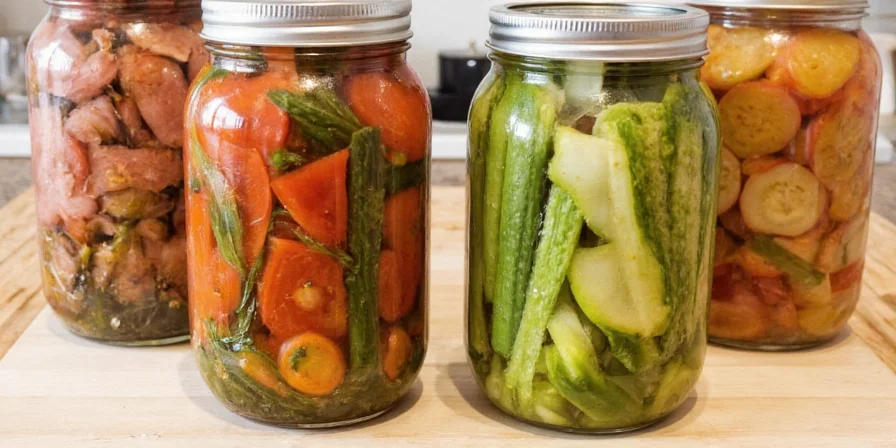
Fermentation vs Pickling: Key Differences You Need to Know
| Aspect | Fermentation | Pickling |
|---|---|---|
| How It Works | Natural bacteria convert sugars to acids (takes days/weeks) | Vinegar immersion (works in hours) |
| Flavor Development | Evolves and deepens over time | Immediate and stable |
| Spice Behavior | Spices mellow and transform (e.g., chilies lose 30-50% heat) | Spices maintain original intensity |
| Best For | Developing complex flavors, probiotic benefits | Preserving bright, fresh flavors quickly |
| Spice Preparation | Use whole spices (prevents sediment) | Crack or toast spices (faster infusion) |
| Storage | Refrigeration required after fermenting | Room temperature stable for months |
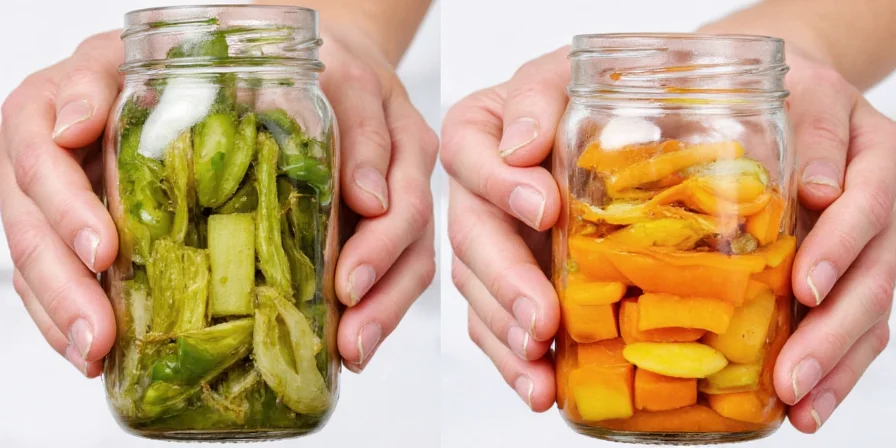
How Spices Behave Differently: Practical Implications
The way spices interact with each preservation method directly impacts your final product. Understanding these differences helps you choose the right spices and preparation methods:
Fermentation-Specific Spice Behavior:
- Chilies gradually lose heat intensity as bacteria break down capsaicin—ideal if you want milder heat over time
- Garlic transforms from sharp to mellow as allicin converts to gentler compounds
- Mustard seeds release flavor slowly, providing balanced bitterness that complements sourness
Pickling-Specific Spice Behavior:
- Chilies maintain full heat intensity for months since vinegar preserves capsaicin
- Turmeric achieves best color at 140°F (60°C)—too hot causes rapid fading
- Dill provides immediate brightness but degrades after 3 weeks—add fresh dill later if storing long-term
When preserving ginger, fermentation creates earthy depth through enzymatic breakdown, while pickling maintains bright, fresh zing. This explains why fermented ginger works better in cooked dishes while pickled ginger shines in fresh preparations.
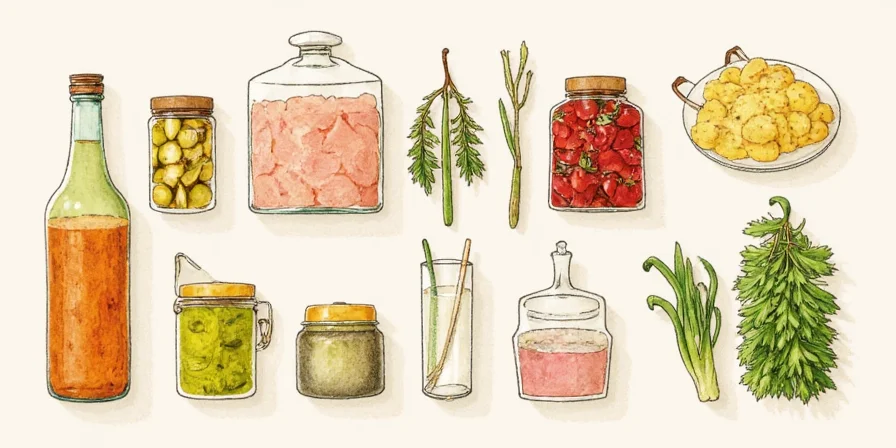
When to Choose Fermentation vs Pickling
Selecting the right method depends on your desired outcome:
- Choose fermentation when: You want complex, evolving flavors; probiotic benefits; or milder spice intensity over time. Ideal for cabbage (sauerkraut), cucumbers (traditional dills), and spicy peppers where you want heat to mellow.
- Choose pickling when: You want immediate results; consistent, bright flavors; or to preserve spice intensity. Best for quick refrigerator pickles, onions, and peppers where you want to maintain maximum heat.
For layered flavor development in fermented items, add heat elements (like chilies) at the beginning to allow mellowing, then introduce delicate herbs during secondary fermentation. In pickling, toast spices to 300°F (150°C) for 4 minutes to maximize flavor extraction before adding to brine.
Proven Techniques for Perfect Results
- For fermentation: Use 0.5% black pepper by weight—piperine inhibits spoilage bacteria without affecting good bacteria
- For pickling: Heat coriander seeds to 300°F (150°C) for 4 minutes before adding to brine to triple flavor release
- Combine fresh and dried chilies in ferments for layered heat (immediate punch plus slow release)
- Maintain 72-75°F (22-24°C) for vegetable ferments—higher temperatures speed the process but risk off-flavors
- Use pH strips to verify safety: Ferments need pH ≤4.2, pickles require ≤3.8
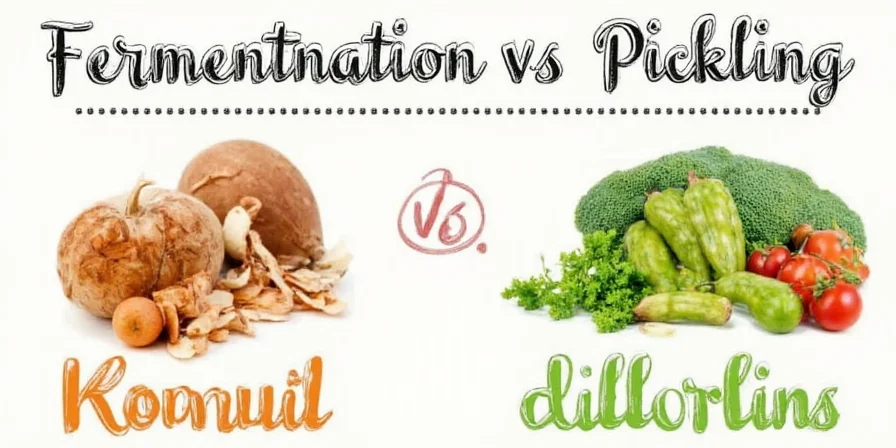
Top 5 Mistakes That Ruin Preserved Foods
- Iodized salt usage: Iodine kills beneficial bacteria—always use non-iodized salt (0.8-2.5% concentration)
- Insufficient headspace: Causes brine overflow and mold—leave 1.5 inches (4 cm) clearance in jars
- Under-acidified brine: Using <5% vinegar risks botulism—never dilute vinegar for pickling
- Ground spices in ferments: Creates sediment and uneven flavor—use whole spices for ferments, grind only for quick pickles
- Temperature fluctuations: Ferments below 65°F (18°C) stall the process—use temperature-controlled environments
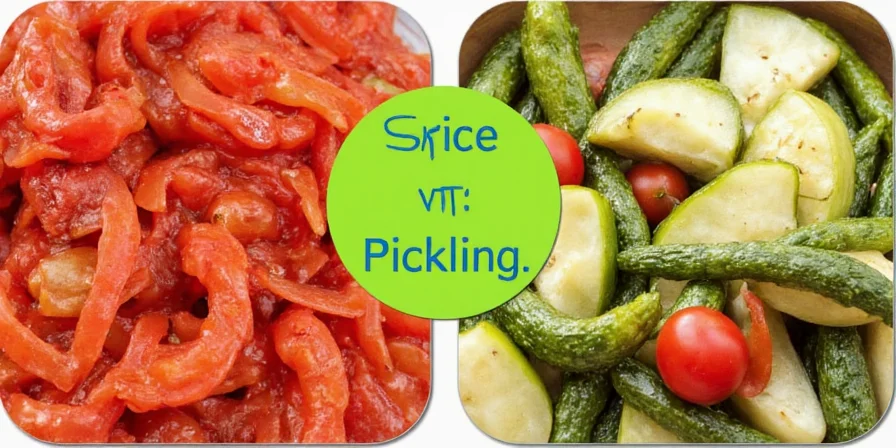
Frequently Asked Questions Answered
Can I convert a fermented recipe to pickling (or vice versa) by adjusting spices?
No—these are fundamentally different preservation methods. Substituting vinegar for brine in kimchi creates unsafe conditions while destroying the microbial ecosystem. Fermenting quick-pickle recipes causes texture degradation. Always follow method-specific recipes.
Why do my fermented chilies lose heat over time while pickled ones stay fiery?
Lactic acid bacteria gradually break down capsaicin into less pungent compounds, reducing heat by 30-50% over 14 days. Vinegar preserves capsaicin's structure, maintaining consistent heat intensity for months.
Does turmeric's color fade faster in fermentation or pickling?
Turmeric fades faster in pickling—curcumin degrades rapidly at pH <4.0, causing yellow-to-brown oxidation within 3 weeks. Fermentation's gradual acidification (pH 3.5-4.2) preserves color for 3+ months. Add 0.1% citric acid to pickling brine to slow discoloration.
How do I prevent garlic from turning blue in pickled products?
Blue discoloration occurs when garlic's compounds react with acid. Prevent it by: 1) Using vinegar ≥5% acidity, 2) Adding 0.5% calcium chloride to brine, 3) Blanching garlic for 30 seconds before pickling. Avoid aluminum or copper containers.
Conclusion: Matching Method to Your Goals
Fermentation and pickling serve different preservation purposes—neither is inherently better. Fermentation creates living food with evolving flavors and probiotic benefits, while pickling delivers immediate, consistent results through acid preservation. The key to success lies in understanding how each method interacts with spices and selecting the right approach for your desired outcome.
For complex, layered flavors that improve with age, choose fermentation. For bright, consistent flavors ready in days, pickling is your solution. By matching your preservation method to your flavor goals and following these science-backed techniques, you'll consistently achieve perfect results—whether preserving your garden harvest or crafting professional-quality condiments.

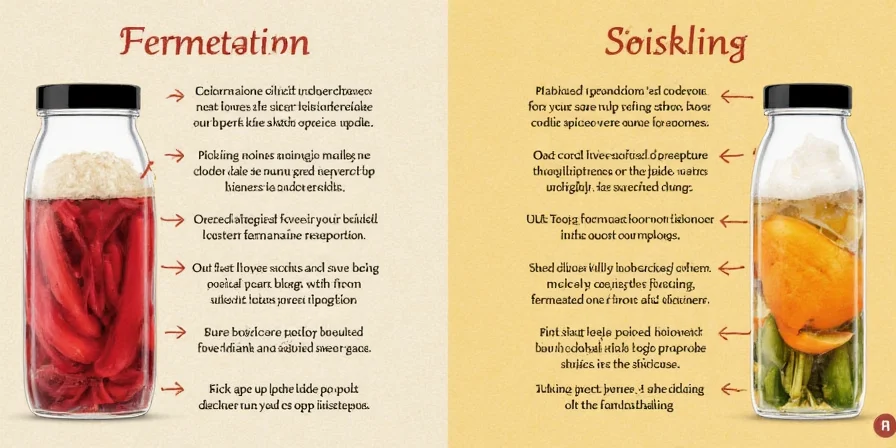









 浙公网安备
33010002000092号
浙公网安备
33010002000092号 浙B2-20120091-4
浙B2-20120091-4